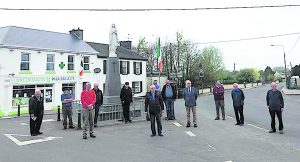
Ballylanders Commemoration Committee published a special booklet to mark the centenary of the burning of the RIC Barracks
Ballylanders Comme-moration Committee, having organised the unveiling of a plaque to mark the centenary of the burning of the local RIC Barracks over one hundred years ago were forced to abandon these plans due to the coronavirus but instead celebrated the event with the publication of a special commemorative booklet.
The attack on the Bally-landers R.I.C. Barracks by the republican movement led to a number of reprisals by British Forces over the following months including the capture of eleven activists, who subsequently went on hunger strike at Cork Gaol on the 11th of August in 1920.
Worldwide attention
They were joined by the Lord Mayor of Cork, Terence MacSwiney who was moved to Brixton prison, with the hunger strike gained the attention of the world’s media.
The story made front-page news in more than 500 daily newspapers throughout the U.S as distressing reports soon began to emerge from the prison, with many believing the end of the struggle was fast approaching. However, it wasn’t until the 18th of October that the first hunger striker, Mick Fitzgerald of Fermoy, passed away. Eight days later the Lord Mayor of Cork and Joseph Murphy passed away.
End of hunger strike
The others continued to hang on for the next two weeks, with no material change in their conditions. At that point, Arthur Griffith, acting President of the Irish Republic, stepped in and essentially ordered that the strike be called off.
“I am of the opinion that our countrymen in Cork Prison have sufficiently proved their devotion and fidelity, and that they should now, as they were prepared to die for Ireland, prepare again to live for her,” Griffith said.
Four from Ballylanders
Nine men survived the hunger strike which went on for 94 days, and four were from Ballylanders, Chris Upton, Michael O’Reilly, John Crowley and Peter Crowley, while another, Thomas Donavan came from Emly.
The prisoners were released after their recovery but many continued to have lifelong health problems.
Chris Upton returned to Ballylanders and eventually purchased what remained of the former RIC barracks in the village, opening a shop which became well known as a foodstore and pharmacy for several decades. The premises now houses McCormack’s Pharmacy.
Chris passed away at the age of 84 as the last survivor of the hunger strike in Cork Gaol, the end of which will be commemorated on this Thursday 12th November.
Health issues
Peter Crowley, having been advised to leave Ireland for medical reasons, was living in the Bronx, New York before the the outbreak of the Civil War.
Peter returned to the new Irish State in the 1930s and moved to Collins Avenue, Dublin where he worked in the civil service. He died from lung cancer on the 8th April 1963.
Michael O’Reilly moved to Mitchelstown and married Bridie Elder, a nurse at Fermoy Military Hospital.
He was in poor health after the hunger strike and underwent several operations, including one in which half his stomach was removed, leading to a restricted diet for the rest of his life.
Michael O’Reilly passed away on the 23rd of January 1965.
His funeral marked the final occasion that the Old IRA volunteers were allowed fire over the grave of a comrade.
Jack Crowley, a former Limerick footballer, never fully recovered from the effects of the hunger strike.
He moved back to Ballylanders and worked in the family business, Katherine Luddy on the 26th of April 1928.
Kathy was an only child and inherited a good sized farm at Spittle, near Ballylanders, where she and Jack lived quietly and happily, farming together until Jack’s death at the early age of 51 on the 22nd October in1942.
(Material and photographs courtesy of Kieran Upton, a great grandson of Chris Upton)